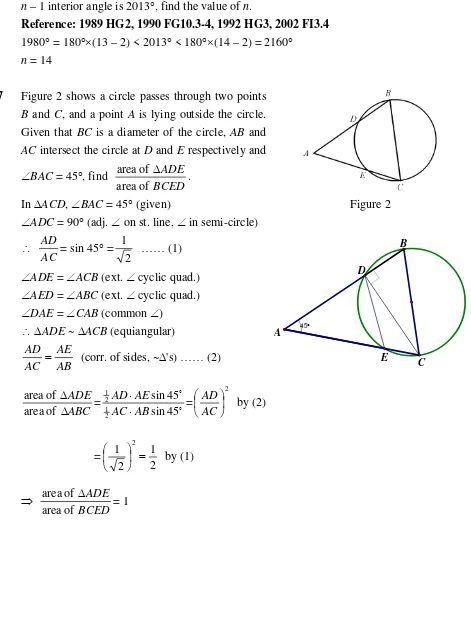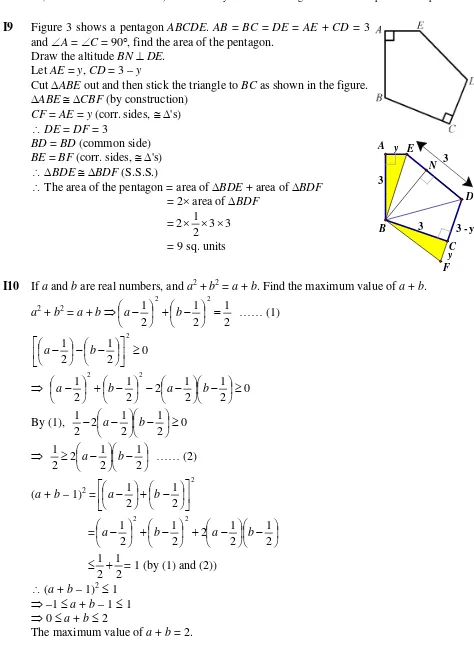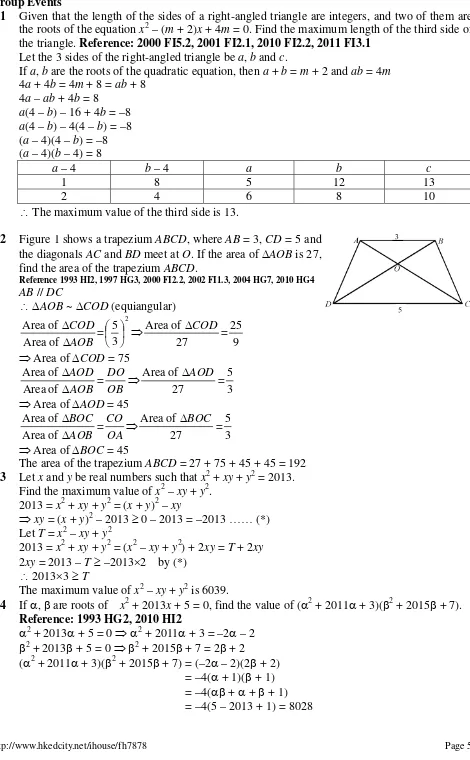1 61 33 2 180 3 30 4 25 5 2012 12-13
Individual 6 14 7 1 8 5 9 9 10 2 1 13 2 192 3 6039 4 8028 5 10 12-13
Group 6 6 7 6 8 130 9 671 10
2013 2
Individual Events
I1 Simplify 942 2013 .
2013 2
94 = 612 613333
=
61 33
2= 61 33
I2 A parallelogram is cut into 178 pieces of equilateral triangles with sides 1 unit. If the perimeter of the parallelogram is P units, find the maximum value of P.
2 equilateral triangles joint to form a small parallelogram. 178 = 289
The given parallelogram is cut into 89 small parallelograms, and 89 is a prime number. The dimension of the given parallelogram is 1 unit 89 units.
P = 2(1 + 89) = 180 units
I3 Figure 1 shows a right-angled triangle ACD where
B is a point on AC and BC = 2AB. Given that AB = a
and ACD = 30, find the value of .
In ABD, AD = tan
a
In ACD, AC = 30 tan
AD
= tan
3a
However, AC = AB + BC = a + 2a = 3a
tan
3a
= 3a
tan = 3
3
= 30
I4 Given that x2 + 399 = 2y, where x, y are positive integers. Find the value of x. 29 = 512, 512 – 399 = 113 x2
210 = 1024, 1024 – 399 = 625 = 252, x = 25
I5 Given that y = (x + 1)(x + 2)(x + 3)(x + 4) + 2013, find the minimum value of y.
Reference 1993HG5, 1993 HG6, 1995 FI4.4, 1996 FG10.1, 2000 FG3.1, 2004 FG3.1, 2012 FI2.3
y = (x + 1)(x + 4)(x + 2)(x + 3) + 2013 = (x2 + 5x + 4)(x2 + 5x + 6) + 2013 = (x2 + 5x)2 + 10(x2 + 5x) + 24 + 2013 = (x2 + 5x)2 + 10(x2 + 5x) + 25 + 2012 = (x2 + 5x + 5)2 + 2012 2012
I6 In a convex polygon with n sides, one interior angle is selected. If the sum of the remaining
n – 1 interior angle is 2013, find the value of n.
Reference: 1989 HG2, 1990 FG10.3-4, 1992 HG3, 2002 FI3.4 1980 = 180(13 – 2) < 2013 < 180(14 – 2) = 2160
n = 14
I7 Figure 2 shows a circle passes through two points
B and C, and a point A is lying outside the circle. Given that BC is a diameter of the circle, AB and
AC intersect the circle at D and Erespectively and BAC = 45, find
BCED ADE
of area
of area
.
In ACD, BAC = 45 (given)
ADC = 90 (adj. on st. line, in semi-circle)
Figure 2
AC
AD= sin 45 =
2
1 (1)
ADE = ACB (ext. cyclic quad.)
AED = ABC (ext. cyclic quad.)
DAE = CAB (common )
ADE ~ ACB (equiangular)
AB AE AC
AD (corr. of sides, ~'s) (2)
ABC ADE
of area
of area
=
45 sin
45 sin 2
1 2 1
AB AC
AE AD
=
2
AC AD
by (2)
45
E D
C B
A
=
2 1 2 1 2
by (1)
BCED ADE
of area
of area
I8 Solve 31 31x = x.
0 < 31 31x < 36 = 6 0 < x < 6 Then 31 31x x2
(31 – x2)2 = 31 + x
x4 – 62x2 – x + 312 – 31 = 0 (x4 – x) – 62x2 + 930 = 0
(x2 – x)(x2 + x + 1) – 62x2 + 930 = 0
We want to factorise the above equation as (x2 – x + a)(x2 + x + 1 + b) = 0
a(x2 + x) + b(x2 – x) = –62x2 (1) and a(1 + b) = 930 (2) From (1), a + b = –62 (3), a – b = 0 (4)
a = b = –31 (5), sub. (5) into (2): L.H.S. = –31(–30) = 930 = R.H.S. (x2 – x – 31)(x2 + x + 1 – 31) = 0
x2 – x – 31 = 0 or x2 + x – 30 = 0
x = 2
5 5 1
, 2
5 5 1
, 5, –6.
2 5 5 1
< 0 and 2
5 5 1
= 2
125 1
> 2
121 1
= 2
11 1
= 6
0 < x < 6 x = 5 only. Method 2
Let 31 31y = y
(y2 – 31)2 = 31 – y, then clearly y > x
and y = 31 31y > 30.25= 5.5
y4 – 62y2 + y + 930 = 0 (2)
(2) – (1): y4 – x4 – 62(y2 – x2) + y + x = 0
(y + x)(y – x)(y2 + x2) – 62(y + x)(y – x) + (y + x) = 0 (y + x)[(y – x)(y2 + x2) – 62(y – x) + 1] = 0
y + x 0 (y – x)(y2 + x2 – 62) + 1 = 0 (3)
Assume x and y are positive integers. Then (3) becomes
(y – x)(y2 + x2 – 62) = –1 y – x = 1 (4) and y2 + x2 – 62 = –1 (5)
From (4), y = x + 1 (6)
Sub. (6) into (5): (x + 1)2 + x2 – 62 = –1
x2 + 2x + 1 + x2 – 61 = 0 2x2 + 2x – 60 = 0
x2 + x – 30 = 0
Group Events
G1 Given that the length of the sides of a right-angled triangle are integers, and two of them are the roots of the equation x2 – (m + 2)x + 4m = 0. Find the maximum length of the third side of the triangle. Reference: 2000 FI5.2, 2001 FI2.1, 2010 FI2.2, 2011 FI3.1
Let the 3 sides of the right-angled triangle be a, b and c.
The maximum value of the third side is 13.
G2 Figure 1 shows a trapezium ABCD, where AB = 3, CD= 5 and the diagonals AC and BD meet at O. If the area of AOBis 27, find the area of the trapezium ABCD.
Reference 1993 HI2, 1997 HG3, 2000 FI2.2, 2002 FI1.3, 2004 HG7, 2010 HG4
AB // DC
Reference: 1993 HG2, 2010 HI2
G5 As shown in Figure 2, ABCD is a square of side 10 units, E and F
are the mid-points of CD and AD respectively, BE and FC
intersect at G. Find the length of AG. Join BF and AG.
CE = DE = DF = FA = 5
Clearly BCE CDF BAF (S.A.S.) Let CBG = x = ABF (corr. s 's)
BCE = 90
BCG = 90 – x
BGC = 90 (s sum of )
Consider ABG and FBC.
BF AB
= cos x
ABG = x + FBG = FBC
BC GB
= cos x
ABG ~ FBC (ratio of 2 sides, included angle)
FC AG FB
AB (corr. sides, ~’s)
FB = FC (corr. sides, CDF BAF) AG = AB = 10
Method 2 Define a rectangle coordinate system with A = origin,
AB = positive x-axis, AD = positive y-axis.
x x
G
F
E
D
C
A
B
B = (10, 0), C = (10, 10), E = (5, 10), D = (0, 10), F = (0, 5) Equation of CF:
0
0 10
5 10
5
x
y y =
2 1
x + 5 (1)
Equation of BE:
10
105 0 10
0
x
y y = –2x + 20 (2)
(1) = (2): 2 1
x + 5 = –2x + 20 x = 6 Sub. x = 6 into (1): y = 8
AG = 62 82 = 10
G6 Let a and b are positive real numbers, and the equations x2 + ax + 2b = 0 and x2 + 2bx + a = 0 have real roots. Find the minimum value of a + b.
Discriminants of the two equations 0
a2 – 8b 0 (1)
(2b)2 – 4a 0 b2 – a 0 (2) a2 8b a4 64b2 64a
a4 – 64a 0
a(a – 4)(a2 + 4a + 16) 0
a(a – 4)[(a + 2)2 + 12] 0 a(a – 4) 0
a 0 or a 4
a > 0 a 4 only
When a = 4, sub. into (2): b2 – 4 0
(b + 2)(b – 2) 0
b –2 or b 2
b > 0 b 2 only
G7 Given that the length of the three sides of ABC form an arithmetic sequence, and are the roots of the equation x3 – 12x2 + 47x – 60 = 0, find the area of ABC.
Let the roots be a – d, a and a + d.
a – d + a + a + d = 12 a = 4 (1)
(a – d)a + a(a + d) + (a – d)(a + d) = 47 3a2 – d2 = 47 d = 1 (2)
(a – d)a(a + d) = 60 a3 – ad2 = 60 (3)
Sub. (1) and (2) into (3): L.H.S. = 64 – 4 = 60 = R.H.S. The 3 sides of the triangle are 3, 4 and 5.
The area of ABC = 3 4 2 1
= 6 sq. units.
G8 In Figure 3, ABC is an isosceles triangle with AB = AC,
BC = 240. The radius of the inscribed circle of ABCis 24. Find the length of AB.
Let I be the centre. The inscribed circle touches AB and CA
at F and E respectively. Let AB = AC = x. Let D be the mid-point of BC.
ABD ACD (S.S.S.) ADB = ADC = 90
corr. s, 's, adj. s on st. line
BC touches the circle at D
(converse, tangent radius)
ID = IE = IF = radii = 24
IEAC, IF AB (tangent radius)
120
x x
24 24
24
120
E F
I A
D
B C
AD = x2 1202 (Pythagoras' theorem)
SABC = SIBC + SICA + SIAB (where S stands for areas)
24 2 1 24 2 1 24 240 2 1 120 240
2
1 2 2
x x x
x x
x
2 1 2 1 240 2 1 120 10
2
1 2 2
2120 120
120
5 x x x
x x120 120 5
25(x – 120) = 120 + x
G9 At most how many numbers can be taken from the set of integers: 1, 2, 3, , 2012, 2013 such that the sum of any two numbers taken out from the set is not a multiple of the difference between the two numbers?
In order to understand the problem, let us take out a few numbers and investigate the property. Take 1, 5, 9.
1 + 5 = 6, 5 – 1 = 4, 6 4k, for any integer k
1 + 9 = 10, 9 – 1 = 8, 10 8k, for any integer k
5 + 9 = 14, 9 – 5 = 4, 14 4k, for any integer k
Take 3, 6, 8.
3 + 6 = 9, 6 – 3 = 3, 9 = 33
3 + 8 = 11, 8 – 3 = 5, 11 5k for any integer k
6 + 8 = 14, 8 – 6 = 2, 14 = 27 Take 12, 28, 40.
12 + 28 = 40, 28 – 12 = 16, 40 16k for any integer k
28 + 40 = 68, 40 – 28 = 12, 68 12k for any integer k
12 + 40 = 52, 40 – 12 = 28, 52 28k for any integer k
We can take three numbers 1, 5, 9 or 12, 28, 40 (but not 3, 6, 8). Take the arithmetic sequence 1, 3, 5, , 2013. (1007 numbers) The general term = T(n) = 2n – 1 for 1 n 1007
T(n) + T(m) = 2n + 2m – 2 = 2(n + m – 1)
T(n) – T(m) = 2n – 2m = 2(n – m)
T(n) + T(m) = [T(n) – T(m)]k for some integer k. For example, 3 + 5 = 8 = (5 – 3)4.
The sequence 1, 3, 5, , 2013 does not satisfy the condition. Take the arithmetic sequence 1, 4, 7, , 2011. (671 numbers) The general term = T(n) = 3n – 2 for 1 n 671
T(n) + T(m) = 3n + 3m – 4 = 3(n + m – 1) – 1
T(n) – T(m) = 3n – 3m = 3(n – m) T(n) + T(m) [T(n) – T(m)]k for any non-zero integer k
G10 For all positive integers n, define a function f as (i) f (1) = 2012,
(ii) f (1) + f (2) + + f (n – 1) + f (n) = n2f (n),n > 1. Find the value of f (2012).
Reference: 2014 FG1.4
f (1) + f (2) + + f (n – 1) = (n2 – 1)f (n) f (n) =
It is observed that the answer is 2012 divided by the nth triangle number. Claim: f (n) =
2012 It is also true for m. By the principle of mathematical induction, the formula is true.
Geometrical Construction
1. Line segment PQ and an angle of size are given below. Construct the isosceles triangle PQR
with PQ = PR and QPR = .
1
3
5
3 4 2
2
6
7
R
J
H F
P
EQ
DSteps. Let the vertex of the given angle be E.
1. Use P as centre, PQ as radius to draw a circular arc QR.
2. Use E as centre, a certain radius to draw an arc, cutting the given angle at D and F
respectively.
3. Use P as centre, the same radius in step 2 to draw an arc, cutting PQ a H.
4. Use D as centre, DF as radius to draw an arc.
5. Use H as centre, DF as radius to draw an arc, cutting the arc in step 3 at J.
6. Join PJ, and extend PJ to cut the arc in step 1 at R.
7. Join QR.
2. Construct a rectangle with AB as one of its sides and with area equal to that of ABC below.
Theory
Let the height of the rectangle be h. Let the height of the triangle be k. Area of rectangle = area of triangle
ABh = ABk
2 1
h = k
2 1
The height of rectangle is half of the height of the triangle.
2
4 3
1
P
Q
D
E
A
B
C
Steps.
1. Draw a line segment CE AB. (E lies on AB, CE is the altitude of ABC)
2. Draw the perpendicular bisector PQ of CE, D is the mid-point of CE.
3. Draw a line segment AQ AB, cutting PQ and Q.
4. Draw a line segment BP AB, cutting PQ and P.
3. The figure below shows two straight lines AB and AC intersecting at the point A. Construct a circle with radius equal to the line segment MN so that AB and AC are tangents to the circle.
Lemma:
如圖,已給一綫段AB,過B作一綫段垂直於AB。
作圖方法如下:
(1) 取任意點C (C在AB之間的上方)為圓心,CB為半徑作
一圓,交AB於P。
(2) 連接PC,其延長綫交圓於Q;連接BQ。
BQ為所求的垂直綫。
作圖完畢。 證明如下:
PCQ為圓之直徑 (由作圖所得)
PBQ = 90 (半圓上的圓周角)
證明完畢。
B
A
Q
P
A
B
C
Steps.
1. Draw the angle bisector AQ
2. Use A as centre, MN as radius to draw an arc.
3. Use the lemma to draw
AP AC, APcuts the arc in step 2 at P.
4. Draw PQ AP, PQ cuts the angle bisector at Q. 5. Draw QR PQ, QR cuts
AC at R.
6. Use Q as centre, QR as radius to draw a circle. This is the required circle. Proof:
2
6 1
3 4
5 S
R
Q P
A
M N C
B
ARQ = 90 (s sum of polygon) APQR is a rectangle.
AC is a tangent touching the circle at R (converse, tangent radius)
Let S be the foot of perpendicular drawn from Q onto AB, QS AB. AQR AQS (A.A.S.)
SQ = SR (corr. sides, 's) S lies on the circle and QS AB



